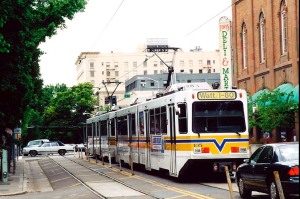
Advantages of Light Rail in Street Alignments
22 April 2013
Sacramento’s light rail system shares space with general traffic in one direction on 12 th St., just north of the city’s CBD. Photo: Eric Haas.
♦
The issue of installing reservations (e.g., reserving existing street lanes) for light rail transit (LRT) in highly constricted urban arterial corridors is a continuously recurring issue for urban public transportation discussions, and it became particularly intense in Austin’s Transit Working Group (TWG) meetings in late April/early May of 2012. Conceding some street space to transit is a wide practice in almost all major world cities, and in the last several decades has become increasingly recognized as a necessity for maintaining mobility in U.S. cities like Austin.
Surface transit, particularly surface LRT, has special advantages — ease of access for passengers, increased public visibility, for example — but it’s also the lowest-cost way to install high-quality rail transit. Of course, using exclusive alignments (which are typically abandoned or lightly used railway corridors) is one way to get lower-cost surface alignments, but these often don’t go through the heart of cities, reaching all the activity centers it’s necessary to serve. One way or another, at least some of the existing grid of urban streets needs to be used.
And they are used, to great success, in cities like Dallas, Houston, San Diego, Sacramento, Portland, Salt Lake City, Denver. Minneapolis, and other cities where some street space has been dedicated to transit. In several other cities, portions of streets are also dedicated to reserved use by buses.
But often it’s hard for public officials, accustomed to accommodating as much motor vehicle traffic as possible, to understand that (especially with urban population growth) this traffic will eventually overwhelm the street system, and that installing urban rail in streets can ultimately achieve far greater and more sustainable mobility. But (despite nominal lip service to advancing a “green” agenda and endorsing public transit conceptually) official policy often remains resistant to giving priority to public transit use of available street space.
Whatever the cause, several members of Austin’s TWG began questioning the relevance of proposed surface LRT for urban rail in key streets of central-city Austin. Instead, they suggested, Austin should shift focus to some kind of subway-elevated system. In response, Lyndon Henry presented a commentary titled Advantages of Light Rail in Street Alignments (11 May 2012) which summarized the benefits of surface construction and pointed to the success of Sacramento’s LRT line (shown in photo above), which uses a number of street alignments in the central city, and runs one of its tracks on 12th St. in shared traffic and the other in a reservation. The following is adapted from the original text of Henry’s printed commentary:
♦
♦ Some important aspects and advantages of surface light rail transit (LRT)
• Much lower capital cost — On average, 1/3 the cost of elevated guideway, 1/10 the cost of subway…
• Lower operating/maintenance cost — Compared with elevated or subway, surface LRT systems and stations are easier and cheaper to operate and maintain…
• Outracing private cars isn’t realistic — Central-city urban rail systems (even subway or elevated services) typically can’t “outrace” cars, because of multiple station-stops. Also, because of frequent center-city stops, <strong>LRT is almost as fast as subway or elevated services…
• Rail’s special attractiveness — Faster than most bus transit; faster than some personal car trips; cheaper than private car travel; riders can read, use laptops, or otherwise use time during travel; eliminates parking hassles; eliminates stress of highway commute; more space, ride comfort, reliability, safety than bus alternative; rail routes easier to understand…
• Available, publicly owned right-of-way — Typically available to a public transit operation…
• Heavily developed corridors — Major established public thoroughfares typically are where much of a city’s activity is and where people want to travel to or from…
• Passengers like the view — Passengers prefer to be able to see the cityscape they’re traveling through — this helps orientate them to where they are…
• Surface stations are more accessible — Typically, surface stations (without stairs, elevators, etc.) are far more accessible to both the general public and passengers with ambulatory constraints…
• Transit deserves priority — Public transit is the sustainable transport of the future, and cities like Austin must start re-prioritizing and re-allocating available street space to favor transit…
• Alignment versatility — LRT has always been a “hybrid” … able to operate in street reservations, mixed traffic, exclusive railway alignments, elevated, subway…
• Design versatility — Street alignments can include a broad range of design options, depending on specific challenges, such as right-of-way width, traffic volume, etc. … including short segments of single track, gantlet (interlaced) track, both tracks in mixed traffic, one track mixed + one track reserved (see example above, Sacramento LRT in 12th St.) Often, these measures are useful for relatively short, more constricted segments of an alignment…
♦ Examples of successful street-routed light rail
• All-reserved lanes — San Diego, Portland (MAX LRT), Baltimore, Denver, Dallas, Salt Lake City, Houston, Tacoma (streetcar), Tampa (streetcar), Phoenix…• Mixed-traffic segments — Sacramento (see photo above), Portland (streetcar), Seattle (streetcar)…

[…] https://austinrailnow.com/2013/04/22/advantages-of-light-rail-in-street-alignments/ […]